
The Cavalry Brigade "Pozzuolo del Friuli" is a brigade of the Italian Army, based in the Friuli-Venezia Giulia and Veneto regions. The Brigade consists of a command unit, a cavalry regiment, an amphibious infantry regiment, an artillery regiment, an engineer regiment and a logistic regiment.

The 131st Armored Division "Centauro" was an armored division of the Italian Army during World War II. The division was formed in April 1939 by expanding the I Armored Brigade. The division's name came from the mythological race of half human-half horse creatures named Centaurs. The division participated in the invasion of Albania, Greco-Italian War, and invasion of Yugoslavia. In August 1942 the division was sent to Libya to participate in the Western Desert Campaign. After the Axis defeat at the Second Battle of El Alamein the division retreated with the German-Italian Panzer Army to Tunisia, where the division participated in the Tunisian Campaign. On 18 April 1943 the division was disbanded due to the losses suffered in the Battle of El Guettar.

After World War II the Italian Army had two units named "Centauro": from 1952 to 1986 the Armored Division "Centauro" and from 1986 to 2002 the Armored Brigade "Centauro". Both units were successor to the World War II era 131st Armored Division "Centauro". The units' name came from the mythological race of half human-half horse creatures named Centaurs.

The 132nd Armored Brigade "Ariete" is currently the only active armored brigade of the Italian Army. Its core units are tank and Bersaglieri regiments. The brigade's headquarters is in Pordenone, and most of its units are based in the North-East of Italy. The brigade's name comes from the battering ram. The brigade draws much of its historical traditions from the 132nd Armored Division "Ariete," which fought in the Western Desert Campaign of World War II. In 1948, the Ariete was reconstituted as a division and remained active until 1986. Today the brigade is part of the Division "Vittorio Veneto".
With the 1975 reforms the Italian Army abolished the regimental level and replaced it with brigades made up of multiple arms. During the reform the army disbanded 48 regimental commands and reduced its force by 87 battalions. A further ten regimental commands were used to raise ten new brigade commands. Ten training centers, which for traditional reasons had carried the names of regiments, were also disbanded. The reduction in units also allowed to mechanize most of the remaining units in Northern Italy and Italy's defense strategy changed from a hold-at-all-costs territorial defense to one of mobile warfare.

The 31st Tank Regiment is an inactive tank regiment of the Italian Army, which was based in Lecce in Apulia and last operationally assigned to the Mechanized Brigade "Pinerolo". The regiment was formed in July 1937 by the Royal Italian Army and assigned to the I Armored Brigade. In April 1939, the regiment moved from Siena to Tirana in occupied Albania. In winter 1940-41 the regiment fought in the Greco-Italian War and in 1941 it participated in the Invasion of Yugoslavia. In November 1942, the regiment was sent to Libya, where it fought in the Western Desert campaign and then in the Tunisian campaign. In April 1943 the regiment was disbanded due to the heavy losses it had suffered in the Battle of El Guettar. The regiment was immediately reformed in Italy, but it saw no further action, until German forces disbanded it after the announcement of the Armistice of Cassibile on 8 September 1943.

The 8th Field Artillery Regiment "Pasubio" is a field artillery regiment of the Italian Army. Today the regiment is based in Persano in Campania and assigned to the Bersaglieri Brigade "Garibaldi". The regiment was formed in 1860 by the Royal Sardinian Army and participated the same year in the Sardinian campaign in Central and Southern Italy. In 1861 the regiment joined the Royal Italian Army and in 1866 it fought in the Third Italian War of Independence. During World War I the regiment served on the Italian front. In 1935 the regiment was assigned to the 9th Infantry Division "Pasubio", which in July 1941 was assigned to the Italian Expeditionary Corps in Russia, which was deployed to the Eastern Front of World War II. In 1942 the division and regiment were destroyed during the Soviet Operation Little Saturn and the survivors of the division were dispersed by invading German forces after the announcement of the Armistice of Cassibile on 8 September 1943.

The 132nd Field Artillery Regiment "Ariete" is a field artillery regiment of the Italian Army, specializing in armored combat. Originally an armored artillery regiment of the Royal Italian Army, the regiment was assigned during World War II to the 132nd Armored Division "Ariete", with which it fought in the Western Desert campaign until the division and regiment were destroyed in the Second Battle of El Alamein.

The 21st Field Artillery Regiment "Trieste" is a field artillery regiment of the Italian Army. Today the regiment is based in Foggia in Apulia and assigned to the Mechanized Brigade "Pinerolo". Originally an artillery regiment of the Royal Italian Army, the regiment was formed in 1888 and served in World War I on the Italian front. In 1935 the regiment was assigned to the 8th Infantry Division "Po", which in 1939 was renamed 101st Motorized Division "Trieste". The division participated in the Greco-Italian War, fought in the Western Desert campaign and was forced to surrender to allied forces on 12 May 1943 at the end of the Tunisian campaign.
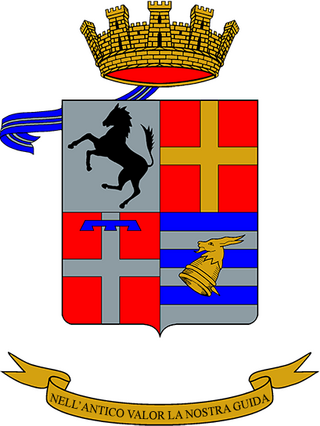
The 24th Field Artillery Regiment "Peloritani" is a field artillery regiment of the Italian Army. Today the regiment is based in Messina in Sicily and assigned to the Mechanized Brigade "Aosta". Originally an artillery regiment of the Royal Italian Army, the regiment was formed in 1888 and served in World War I on the Italian front. In 1935 the regiment was assigned to the 29th Infantry Division "Peloritana", which fought in the Second Italo-Ethiopian War. In 1939 the division was renamed as the 29th Infantry Division "Piemonte". The division participated in the Greco-Italian War and then remained in Yugoslavia on anti-partisan duty. The division and regiment were located on the Peloponnese peninsula, when the Armistice of Cassibile was announced on 8 September 1943. The division and its units surrendered to attacking German forces on 11 September.
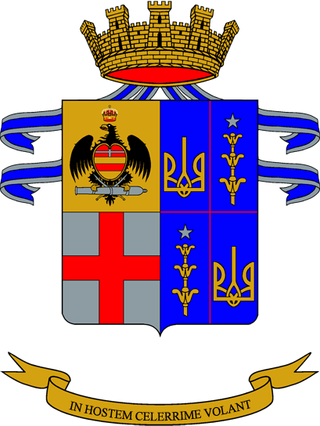
The Field Artillery Regiment "a Cavallo" is a field artillery regiment of the Italian Army. The regiment carries and maintains the traditions of all Royal Sardinian Army, Royal Italian Army and Italian Army horse artillery units and includes a historic section with horse-drawn guns. The Royal Sardinian Army formed the first horse batteries in 1831, which in 1887 were merged to create the Horse Artillery Regiment. In World War I the regiment's batteries were assigned to the Royal Italian Army's four cavalry divisions, which fought on the Italian front.
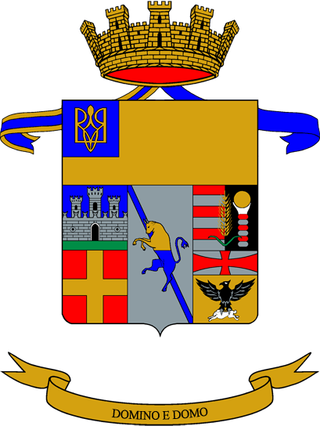
The 52nd Field Artillery Regiment "Torino" is an artillery regiment of the Italian Army trained for divisional artillery support. Since September 2020 the regiment is based together with the 8th Field Artillery Regiment "Pasubio" in Persano in Campania. The regiment is assigned to the army's Artillery Command.

The 205th Artillery Regiment "Bologna" is an inactive field artillery regiment of the Italian Army, which was based in Vercelli in Piedmont. Originally an artillery regiment of the Royal Italian Army, the regiment was assigned in World War II to the 25th Infantry Division "Bologna", with which the regiment was deployed to North Africa for the Western Desert campaign, during which division and regiment were destroyed in the Second Battle of El Alamein. The unit was reformed in 1975 and disbanded in 1991 after the end of the Cold War. The regimental anniversary falls, as for all Italian Army artillery regiments, on June 15, the beginning of the Second Battle of the Piave River in 1918.
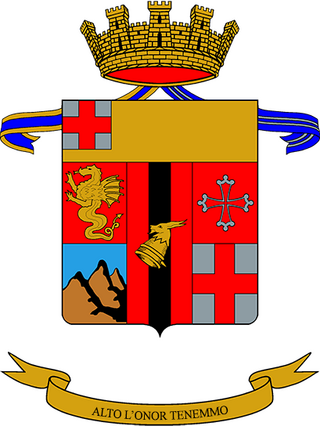
The 33rd Artillery Regiment "Acqui" is an inactive field artillery regiment of the Italian Army, which was based in L'Aquila in Abruzzo. Originally an artillery regiment of the Royal Italian Army, the regiment was formed in 1915 and served in World War I, before being disbanded after the war. The regiment was reformed in 1939 and assigned in World War II to the 33rd Infantry Division "Acqui", with which the regiment fought in the Greco-Italian War. The division and regiment were located on the Greek island of Cephalonia when the Armistice of Cassibile was announced on 8 September 1943. The division refused German demands to surrender and fought German forces landing on the island. On 22 September the division surrendered and afterwards the Germans shot the division's officers and most its troops.
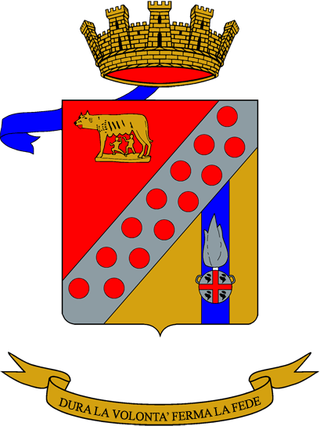
The 13th Artillery Regiment "Granatieri di Sardegna" is an inactive field artillery regiment of the Italian Army, which was based in Civitavecchia in Lazio. Originally an artillery regiment of the Royal Italian Army, the regiment was formed in 1888 and served in World War I on the Italian front. In 1935 the regiment was assigned to the 21st Infantry Division "Granatieri di Sardegna", with which the regiment served in World War II. After the Armistice of Cassibile was announced on 8 September 1943, the division and its regiments defended Rome against invading German forces until 10 September. However the flight of the Italian King Victor Emmanuel III made further resistance senseless and after handing their weapons over to civilian resistance fighters the division surrendered to the Germans, which disbanded the division and its units on 12 September.

The 9th Artillery Regiment "Pistoia" is an inactive field artillery regiment of the Italian Army, which was based in Vercelli in Piedmont. The regiment was formed in 1861 by the Royal Italian Army and fought in 1866 in the Third Italian War of Independence. During World War I the regiment served on the Italian front. In 1935 the regiment was assigned to the 11th Infantry Division "Brennero". In December 1940 the division was transferred to Albania for the Greco-Italian War. After the German invasion of Greece in April 1941 the division remained in Greece on occupation duty until February 1943, when it moved to Albania to be reorganized as a motorized division. The division and its regiments dissolved after the announcement of the Armistice of Cassibile on 8 September 1943.

The 1st Artillery Regiment "Cacciatori delle Alpi" is an inactive field artillery regiment of the Italian Army, which was based in Bracciano in Lazio. The regiment was formed in 1871 by the Royal Italian Army. During World War I the regiment served on the Italian front. In 1935 the regiment was assigned to the 22nd Infantry Division "Cacciatori delle Alpi", with which the regiment served in the Greco-Italian War of World War II. In July 1941 the division was sent to occupied Yugoslavia on occupation duty. After the announcement of the Armistice of Cassibile on 8 September 1943 the division and its regiments were disbanded on 11 September by invading German forces.

The 11th Field Artillery Regiment is an inactive field artillery regiment of the Italian Army, which was based in Cremona in Lombardy. The regiment was formed in 1884 by the Royal Italian Army and served during World War I on the Italian front. In 1935 the regiment was assigned to the 3rd Infantry Division "Monferrato" and designated as 11th Artillery Regiment "Monferrato". In 1939 the division became the 3rd Infantry Division "Ravenna" and consequently the regiment was renamed 11th Artillery Regiment "Ravenna". In June 1942 the Ravenna division was ordered to deploy to the Eastern Front of World War II and before departing Italy the division exchanged artillery regiments with the 104th Infantry Division "Mantova".

The 2nd Heavy Field Artillery Regiment is an inactive artillery regiment of the Italian Army, which was based in Barletta in Apulia and assigned to the Mechanized Brigade "Pinerolo". Originally an artillery regiment of the Royal Italian Army, the regiment was formed in 1920 with pre-existing groups, which had fought during World War I on the Italian front. During World War II the regiment formed two army corps artillery groupings, one of which participated in 1940 in the invasion of France and in 1942-43 served with the Italian 8th Army on the Eastern Front. The other grouping fought in 1941 in the Greco-Italian War and served in 1942 in the occupation of Vichy France. The regiment and its groupings were disbanded by invading German forces after the announcement of the Armistice of Cassibile on 8 September 1943.

The 12th Heavy Field Artillery Regiment is an inactive artillery regiment of the Italian Army, which was based in Vercelli in Piedmont and assigned to the 3rd Army Corps. Originally an artillery regiment of the Royal Italian Army, the regiment was formed in 1920 with pre-existing groups, which had fought during World War I on the Italian front. During World War II the regiment formed an army corps artillery grouping, which in 1943 fought against the allies during the invasion of Sicily. The regiment and its depot were lost when allied forces entered Palermo on 22 July 1943, while the grouping was disbanded in August 1943 after it had retreated from Sicily to Calabria in Southern Italy.



















